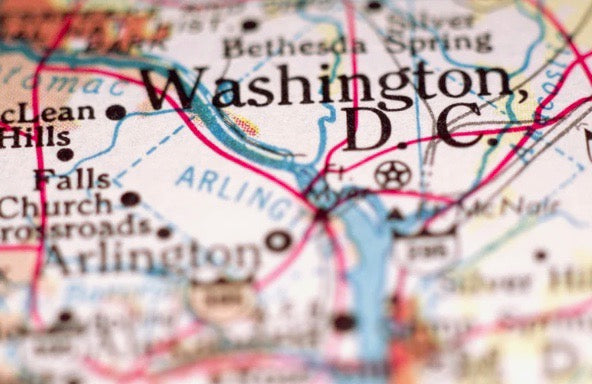
DOGE: Retrocession
Share
The purpose of this article is to examine the legitimacy of returning much of the District of Columbia to Maryland. Congress originally acquired the land for the nation’s capital through cessions from both Maryland and Virginia. This land was designated to establish a permanent seat of government separate from any state’s jurisdiction.
District of Columbia is Established
Before Washington, D.C., Philadelphia served as the capital of the United States. The decision to create a new capital led to the ceding of land from Maryland and Virginia, forming a federal district along the Potomac River. In 1800, the federal government officially moved to the newly constructed District of Columbia.
In 1846, Congress retroceded the portion of the District of Columbia that had been ceded by Virginia. This decision returned Alexandria and Arlington to Virginia after concerns arose over representation, economic interests, and the declining importance of the area to the federal government. The retrocession serves as a precedent for considering a similar return of land to Maryland.

District of Columbia is Expensive
Since its establishment, the District of Columbia has been under the authority of Congress. It houses numerous federal agencies and institutions, with hundreds of government buildings throughout its jurisdiction. Today, the District remains the administrative heart of the nation, though its role has evolved significantly.
Over the last fifty years, the District of Columbia has been the center of numerous political scandals. Corruption among local officials, financial mismanagement, and a reliance on increasing federal funding have raised concerns about governance. Federal money continues to pour into the District, with Congress allocating substantial resources annually to support its operations.
Many D.C. residents, local leaders, and federal politicians have pushed for statehood, citing taxation without representation. The District’s population is comparable to states like Delaware and Rhode Island, yet it lacks voting representation in Congress. While statehood remains a debated issue, one potential alternative is returning most of the District to Maryland.
- Statehood could be achieved by reintegrating the District with Maryland.
- Virginia previously regained its portion of the original District of Columbia through retrocession.
- There is historical precedent and legitimacy in returning land to its original state.

District of Columbia is Returned
When Congress admitted new territories into the Union, economic sustainability played a critical role. Territories had to demonstrate they could sustain themselves through agriculture, industry, or natural resources. Without such factors, territories were unlikely to achieve statehood.
The District of Columbia lacks the economic independence that past territories were required to demonstrate. Its funding relies heavily on federal support, and its economic base is centered around government operations. Given these realities, the most practical approach is returning the majority of the District to Maryland.
A retrocession plan could limit the federal district to an area encompassing the White House, National Mall, Capitol Building, and Supreme Court. The rest of the land would return to Maryland’s jurisdiction, integrating its residents into the state’s governance structure. This would provide representation to D.C. residents while maintaining a separate core for federal operations.
The land being returned is not essential to the functioning of the federal government. A temporary two-year funding plan could ease the transition, ensuring Maryland is prepared to assume full jurisdiction. Over time, this shift would relieve federal taxpayers from unnecessary expenditures on a district no longer required in its current size.
- Reducing federal expenses aligns with national efforts to improve efficiency.
- Residents would benefit from full state representation and services.
- Congress has historically exercised wisdom in structuring statehood, and this situation warrants a similar approach.
Summary
As federal agencies decentralize and reduce their presence in Washington, D.C., the need for a large federal district diminishes. Much of the bureaucracy will be streamlined, and authority will shift to state governments. Maintaining an oversized District of Columbia no longer serves a practical purpose.
The financial burden of supporting the District can be significantly reduced through retrocession. By returning land to Maryland, taxpayers can save billions while ensuring fair governance for residents. These cost savings can contribute to reducing the national debt and improving the efficiency of federal operations.
At WaveRocket, we blend thought-provoking messaging with high-quality T-shirts that celebrate American pride and a culture of success. Explore more engaging content on history, politics, and culture at WaveRocket Posts
by Jolene Wilson

